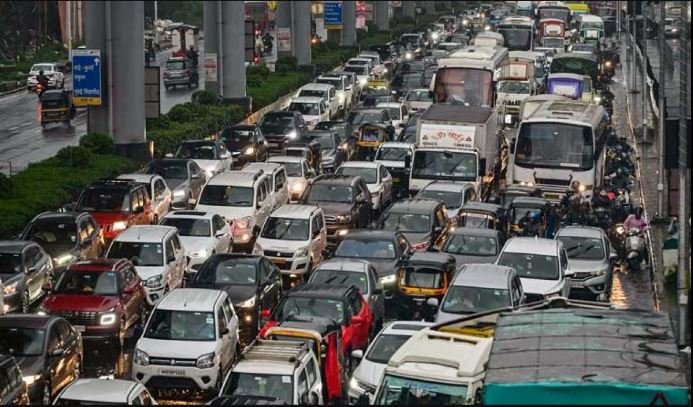Reducing traffic congestion with tech solutions has become a top priority for cities worldwide. Rapid urbanization and population growth have led to overcrowded roads, longer travel times, and environmental pollution. Fortunately, emerging technologies offer innovative ways to ease traffic jams and enhance the efficiency of transportation systems. From smart traffic lights to real-time data analysis, tech-driven solutions are transforming urban mobility and addressing one of the most pressing challenges of modern cities.

Smart Traffic Management Systems
Cities reduce traffic congestion by implementing smart traffic management systems. These systems utilize sensors and artificial intelligence (AI) to monitor and manage traffic flow in real time. By analyzing data from cameras, GPS devices, and connected vehicles, smart traffic systems optimize traffic signals, adjust speed limits, and redirect vehicles away from congested areas. This dynamic approach reduces traffic buildup during peak hours and ensures smoother movement across busy intersections.
In addition, AI-driven algorithms predict traffic patterns based on historical data, helping city planners make informed decisions about road infrastructure. Cities use this data to adjust traffic management strategies and minimize congestion in high-traffic zones. Smart traffic management improves overall travel times, reduces fuel consumption, and lessens air pollution caused by idling vehicles.
Real-Time Traffic Data and Navigation Apps
Another effective way cities reduce traffic congestion is by leveraging real-time traffic data. Navigation apps such as Google Maps and Waze provide drivers with up-to-the-minute traffic updates, allowing them to avoid congested routes. These apps collect data from various sources, including traffic sensors, cameras, and users’ mobile devices, to offer the fastest and most efficient routes for drivers.
With real-time data, drivers receive notifications about accidents, road closures, and traffic jams, enabling them to make better route decisions. Additionally, ride-sharing companies like Uber and Lyft rely on traffic data to optimize routes for their drivers, reducing overall congestion in densely populated areas. Cities that promote the use of navigation apps experience fewer traffic bottlenecks and more efficient use of their road networks.
Connected Vehicles and Autonomous Technology
Connected vehicle technology plays a significant role in reducing traffic congestion by improving communication between vehicles and road infrastructure. Cars equipped with Vehicle-to-Everything (V2X) technology share real-time data with traffic signals, other vehicles, and even pedestrians. This communication allows vehicles to adjust their speed, avoid sudden stops, and prevent accidents, leading to a smoother flow of traffic.
Autonomous vehicles, currently in development, also promise to revolutionize traffic management. Self-driving cars use AI, sensors, and real-time data to navigate roads without human intervention. By eliminating human error, autonomous vehicles reduce the likelihood of accidents and improve overall traffic flow. As more autonomous vehicles hit the roads, cities will experience fewer traffic jams and a significant improvement in transportation efficiency.
Promoting Public Transportation Through Apps
Technology also supports the reduction of traffic congestion by promoting public transportation. Cities reduce the number of cars on the road by encouraging citizens to use public transit systems. Mobile apps now offer real-time updates on bus and train schedules, allowing commuters to plan their trips more efficiently. These apps also provide information about seat availability, delays, and alternative routes, enhancing the convenience of public transportation.
In some cities, tech solutions enable dynamic pricing for public transit, offering discounts during off-peak hours to reduce crowding during rush hour. By making public transportation more accessible and user-friendly, cities encourage more people to leave their cars at home, leading to reduced traffic congestion and lower carbon emissions.
Advanced Parking Solutions
Parking-related traffic accounts for a large portion of urban congestion, as drivers often spend significant time searching for available spots. Advanced parking solutions reduce this issue by using sensors and mobile apps to provide real-time information on available parking spaces. Drivers receive notifications about nearby open spots, reducing the time spent circling the block.
Some cities have introduced smart parking meters that adjust pricing based on demand, encouraging drivers to park in less crowded areas. This system ensures a more even distribution of parked vehicles, reducing the overall congestion in busy areas. By simplifying the parking process, advanced parking solutions contribute to smoother traffic flow in urban environments.
Conclusion
Cities effectively reduce traffic congestion by leveraging tech solutions such as smart traffic management systems, real-time data, and connected vehicle technology. These innovations enhance traffic flow, improve travel times, and reduce the environmental impact of transportation. By continuing to embrace technological advancements, cities can build more sustainable and efficient transportation networks that alleviate the growing problem of traffic congestion.



